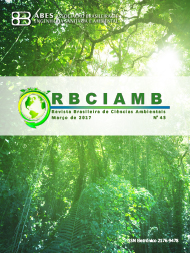ECOLOGICAL FUNCTIONALITY OF RESTORATION OF DEGRADED AREAS IN THE MATA ATLANTICA BIOME, RIO DE JANEIRO, BRAZIL
DOI:
https://doi.org/10.5327/Z2176-947820170175Keywords:
indicators; monitoring; ecological process.Abstract
The ecological functionality of a restored area is associated with the return of processes such as nutrient cycling, input and establishment of new propagules, which can be promoted by the appropriate species selection and the promotion of functional diversity and of species. In a restoration of 50 ha in Rio de Janeiro, Brazil, evaluations were carried out at 5 and 20 months after planting, aiming to analyze the establishment of ecological processes in the restoration and to identify representative indicators. For this purpose, a set of indicators was applied in 23 plots (25 x 4 m): (a) structure - basal area (AB) [ΣAB and AB/m²], mean height of individuals and density (number of individuals/ha); (b) community diversity - Shannon diversity (H’) and equitability (J’) indexes, and species richness (S=number of species); (c) ecological function - presence of species of functional groups (% of zoocoric, pioneers and N2 fixers) and; (d) landscape context - grass cover (soil cover with grasses and projections of crowns in soil and % of natural regeneration). The differences between the years for the indicators were assessed by the chi-square test. To determine which indicators influenced the results, using the unweighted pair group method with arithmetic mean method to principal components analysis (PCA) with 15 indicators x age was performed. Of the total of 88 species observed in both periods, 15 were dominant, with 51.1% of the planted individuals. In this group, 8 had mortality rates over 70%. It is suggested that the planting of these species in high density can cause a so-called process of looping, caused by the opening of gaps over time, facilitating the reestablishment of invasive grasses. The most efficient indicators for evaluating the areas were density, diversity, equitability (H’ and J) and canopy cover. Between 5 and 20 months of age, there was a significant reduction of richness, higher for families than for species. However, the ecological function did not vary among the ages, despite the reduction in diversity, showing that there was functional redundancy between different species.Downloads
Download data is not yet available.
Downloads
Published
2017-07-01
How to Cite
Altivo, F. de S., & Piña Rodrigues, F. C. M. (2017). ECOLOGICAL FUNCTIONALITY OF RESTORATION OF DEGRADED AREAS IN THE MATA ATLANTICA BIOME, RIO DE JANEIRO, BRAZIL. Revista Brasileira De Ciências Ambientais, (43), 17–31. https://doi.org/10.5327/Z2176-947820170175
Issue
Section
Articles
License
Copyright (c) 2017 Revista Brasileira de Ciências Ambientais

This work is licensed under a Creative Commons Attribution 4.0 International License.


























